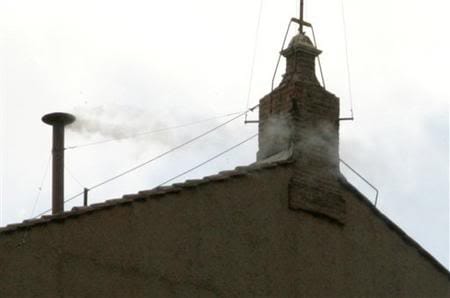conclave

In present-day parlance, a conclave is a gathering of a group of people, especially one held in private, and particularly that of the cardinals of the Roman Catholic Church for the purpose of selecting a new pope. The English word comes from either, or both, the French conclave and the Latin conclave, a locked room or chamber, con- (together) + -clavis (key). By 1245, in Anglo-Latin, and perhaps in other Latin dialects, it could also refer to a papal conclave.
The earliest known use of conclave in English is to a papal conclave in John Gower’s 1393 Confessio Amantis. The relevant passage is about the selection of Celestine V in 1294 after a two-year deadlock among the cardinals following the death of Nicolas IV in 1292:
And thus whan that he passed was,
The cardinals, that wolden save
The forme of lawe, in the conclave
Gon for to chese a newe pope.
(And thus when he died, the cardinals who wanted to maintain the form of law, in the conclave proceeded to choose a new pope.)
Forme of lawe is a reference to the papal bull Ubi periculum, promulgated by Gregory X in 1274 that had established the papal conclave, including its rules of seclusion, for choosing the next pope. But the papal bull had not been enforced, with the popes between Gregory and Celestine being chosen in open election.
Use of conclave to refer to other private gatherings dates to the mid sixteenth century, at first to gatherings of an ecclesiastical nature and by the nineteenth century to secular gatherings as well.
But early English usage also had the sense of a locked room. While this sense is recorded in English after the papal sense, it is likely that both borrowed at the same time, with the gap accounted for by a lacuna in the extant manuscripts. The earliest surviving example of the locked room sense is from a pilgrim’s guide to Rome (sort of a medieval Fodor’s guide) from c. 1450:
A noþir litil chapel is by and on þe auter stand to elde pileris of ston whech pileres þei sey stood in þat conclaue at Nazareth wher gabriel told our lady þoo first heuenely tydyngis.
(Another little chapel is nearby and on the altar stands two old pillars of stone; they say those pillars had stood in that conclave at Nazareth where Gabriel told our lady the first heavenly tidings.)
The Oxford English Dictionary (in an entry written in 1891) has a citation of conclave in the sense of a locked room from the Coventry Mysteries from before 1400, but this is erroneous. When the entry was written, these mystery plays were thought to have originated in Coventry, but more recent scholarship puts them no earlier than 1425 (the extant manuscript dates to 1468) and with an origin in East Anglia. The collection of plays is now generally referred to as the N-Town Plays. The passage, which expresses the antisemitism typical of medieval England, reads:
Pylat ful redyly the body doth hem graunt,
Than thei with reverens do put it in grave.
The Jewyes more wyckyd than ony geawunt,
ffor Crystes ded body kepers do thei crave,
Pylat sendyth iiij. knytes that be ryth hardaunt,
To keep the blody in his dede conclave.
(Pilate did full readily grant him [Nicodemus] the body, so they could with reverence put it in the grave. Because the Jews, more wicked than any giant, asked the attendants for Christ’s dead body, Pilate sent four knights who were very courageous to keep the body in its dead conclave.)
So conclave exhibits several changes in meaning over the centuries, from the literal sense of a locked room—a sense that eventually became archaic—to a private meeting of cardinals to elect a new pope, to any ecclesiastical meeting, to just any meeting.
Sources:
Capgrave, John. Ye Solace of Pilgrimes: A Description of Rome (c. 1450). C. A. Mills, ed. London: Oxford UP, 1911, 71. Archive.org.
Gower, John. Confessio Amantis (1393), second edition, vol. 2 of 3. Russell A. Peck, ed. TEAMS Middle English Text Series. Kalamazoo, Michigan: Medieval Institute Publications, 2013, Book 2, lines 2810–13.
Halliwell, James Orchard, ed. Ludus Coventriæ. London: Shakespeare Society, 1841, 15. HathiTrust Digital Archive.
Latham, Ronald E., David R. Howletter, and Richard K. Ashdowne, eds. Dictionary of Medieval Latin from British Sources, Oxford: Oxford UP, 2013. Brepols: Database of Latin Dictionaries.
Lewis, Charlton T. and Charles Short, eds. A Latin Dictionary. Oxford: Clarendon Press, 1879, s.v. conclave, n. Brepols: Database of Latin Dictionaries.
Middle English Dictionary, 4 March 2025, s.v. conclave, n.
Oxford English Dictionary, second edition, 1989, s.v. conclave, n.
Photo credit: Vdp, 2005. Wikimedia Commons. Licensed under a Creative Commons Attribution-Share Alike 3.0 Unported license.